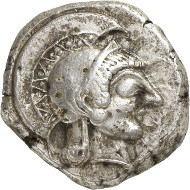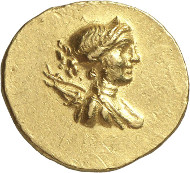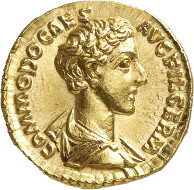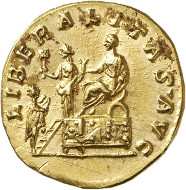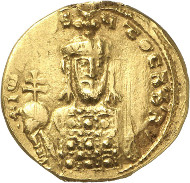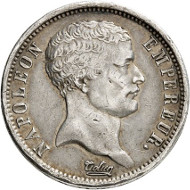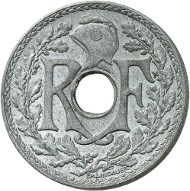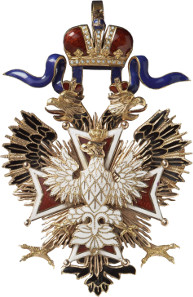08-03-2015 – 11-03-2015
Auctions 228-230
Gorny & Mosch Presents Archaic Owls and a Collection of French Coins
Immediately following the Munich Numismata, the auction of Gorny & Mosch will kick off on March 9, 2015. As always, it presents the high-quality ancient coins on the first day. Tuesday is devoted to auction #229 with further ancient coins and a large offer of multiple lots. Wednesday is reserved for the modern issues, while the Islamic and Russian coins are offered for sale on Thursday. That makes plenty of good reasons to come to Munich and participate in the auction.
Auction 228 – High-Quality Ancient Coins
The top item amongst the coins from Southern Italy and Sicily is a magnificent, attractively toned tetradrachm of the Siculo-Punians (Lot 44; estimate: 12,000 euros), with Tanit being on a par with the best of Syracusan coins in terms of the fine die cutting. Besides, the about extremely fine piece has an impressive pedigree: it had been acquired from the Italian auction house Ratto in 1945.
Lot 45: PANTIKAPEION (Taurian Chersonese). Tetradrachm, 355-320. Ex Gorny & Mosch 146 (2006), 84. Very rare. Extremely fine. Estimate: 15,000,- euros.
Anyone looking for something more special might well turn over. On the next pages he finds an extremely rare tetradrachm from Pantikapeion with the depiction of a grazing horse on the reverse (Lot 45; estimate: 15,000 euros), an excellent portrait of Philip V on one of the rarer tetradrachms of this ruler (Lot 79; estimate: 7,500 euros), an extremely rare stater of the Aetolian League with an apparently unpublished mintmark (Lot 101; estimate: 7,500 euros) and a gold drachm from Karystos on Euboia as they have been minted during the anti-Macedonian revolt from 313 B. C. (Lot 108A; estimate: 7,000 euros).
Lot 111: ATHENS (Attica). Tetradrachm, 500-483. About extremely fine. Estimate: 20,000,- euros.
In the light that this is already spectacular, how can we describe what comes next, a series of rare Athenian tetrachdrachms dating from the Archaic Period? The top item is an early piece from around 500 to 483 that was struck on an unusually broad planchet that displays the crest of Athena’s helmet in full (Lot 111; estimate: 20,000 euros). The fine Archaic smile, however, is available for considerably less money: a roughly contemporary teradrachm on a smaller planchet but with a stylistically finer obverse die is estimated at 2,000 euros (Lot 113). Special interest is likely to be aroused by a late Classical tetradrachm that, as can be inferred from the bull’s head as mintmark, was certainly not produced in Athens but issued as an imitation possibly in Western Asia Minor or the Levant (Lot 120; estimate: 2,500 euros).
The earlier Athenian “Wappenmünzen” are secondary to the series of tetradrachms in this catalog. One discovers two didrachms (Lot 124; type: wheel; estimate: 10,000 euros – Lot 125; type: gorgoneion; estimate: 10,000 euros) and a drachm (Lot 126; type: wheel; estimate: 2,500 euros).
Lot 144: EPHESOS (Ionia). Stater, around 130 B. C. Extremely rare. Extremely fine. Estimate: 25,000,- euros.
The most outstanding piece in the section of Asia Minor is one of the gold staters from Ephesus that have hitherto been thought to be associated with the conquest of Mithradates VI. Jenkins, on the other hand, was able to prove that the first ones of these have actually been minted at a much earlier date. Having said that, the extremely fine stater that features the Greek Artemis on its obverse and the Artemis of Asia Minor on its reverse still is an icon of the coinage of Asia Minor (Lot 144; estimate: 25,000 euros).
Anyone interested in the ancient coinage of the Near East might start saving up money. Two very rare tetradrachms from the Seleucid province Persis in finest condition are on offer. The first is a tetradrachm of Baydad, who became satrap of the province Persis shortly before 300 B. C., as the first indigenous Persian ever (Lot 176; estimate: 12,000 euros), the second is the same nomination of his distant successor called Vadfradad II dating from the first half of the 2nd century B. C., who refers to himself on his coin as frataraka, keeper of the fire, a high title in Zoroastrianism.
In 238 AD, the Parthians conquered the major part of the Persis. Of conqueror Shapur Gorny & Mosch offers an extremely fine dold dinar (Lot 181; estimate: 12,000 euros). Almost equally as rare is the gold stater of Vahran II (Lot 182; estimate: 10,000 euros).
A great rarity is hidden amongst the Greek coins from Roman imperial times: a drachm bearing the portraits of the Armenian king and Augustus, token of a short-lived agreement between Armenia and the Roman Empire (Lot 199; estimate: 17,000 euros).
Lot 638: COMMODUS as Caesar, 166-177. Aureus, 172-176. Rev.: LIBERALITAS AVG Liberalitas scene. Brilliant uncirculated. Estimate: 35,000,- euros.
With this, we have arrived at Rome. When it comes to this section, auction #228 leaves nothing to be desired: gold, silver, bronze, a large collection of coins from the Roman Republic including many rarities – every aficionado of the Romans will find something to his liking.
Let us start with the large series of aurei: there are the ones of Tiberius (Lot 562; EF; estimate: 7,000 euros), for example, and of Commodus (Lot 638; FDC; estimate: 35,000 euros), Philipp I (Lot 669; EF; estimate: 25,000 euros), Hostilian (Lot 674; EF+; estimate: 25,000 euros) or of Trebonianus Gallus (Lot 767; FDC; estimate: 25,000 euros).
To anyone more fond of bronze coins we recommend the sestertius of Claudius (Lot 576; EF; estimate: 8,000 euros), the sestertius of Vespasian (Lot 595; EF+; estimate: 5,000 euros) or the bimetallic medallion of Philip I (Lot 670; VF; estimate: 8,500 euros).
Lot 770: JOHN I TSIMISKES, 969-976. 2 solidi gold bulla. Unpublished unique specimen. Very fine. Estimate: 40,000,- euros.
There are some particular rarities available for the admirers of Late Rome and Byzantium, like a solidus of Glycerius (Lot 727; about EF; estimate: 30,000 euros), a solidus of Michael III (Lot 768; EF+; estimate: 14,000 euros) and an unpublished gold bulla in the weight of two solidi of John I Tsimiskes (Lot 770; VF; estimate: 40,000 euros).
Auction 229 – Ancient Coins and Multiple Lots
More ancient coins are to be found in catalog 229. They will be auctioned on the second day of the auction week. Here, too, the aficionado discovers coins of the Celts, the Greeks, the Romans and the Byzantines as well as the famous multiple lots that virtually enjoy cult status in Munich. He who collects ancient coins can enter the bidding in the two-digit region.
As always, the many interesting bronze coins are remarkable, as is the large series of fractions, including numerous unpublished specimens.
It is clear to see that it still does not take a great deal of money to assemble a thrilling collection of ancient coins.
Amongst the Romans, the connoisseur finds several historically telling reverse depictions, like an aureus of Caracalla, whose reverse shows a sacrifice in front of the Temple of Vesta (Lot 1761; VF; estimate: 2,500 euros).
Auction 230 – Medieval and Modern Issues / Collection France and Colonies / Collection Russia
As is tradition, the auction is concluded by coins and medals from medieval and modern times. It all starts with German coins featuring several rarities, like a very rare thaler of Frederick William, Elector of Brandenburg, from 1675 on the victory at Fehrbellin (Lot 3050; EF; estimate: 3,000 euros) or a reichsdoppelthaler from 1592 of Georg Friedrich of Brandenburg-Ansbach for Silesia-Jägerndorf (Lot 3230; EF; estimate: 5,000 euros).
The medals include a small collection of religious medals.
Lot 3478: FRANCE. Napoleon I, 1804-1814. 2 francs 1807 A, Paris. Auction Künker 206 (2012), 2867. Very rare. Very fine. Estimate: 2,000,- euros.
The centerpiece of the European coins and medals is an almost complete collection of French coin types since 1789 as well as some coins struck in German under French occupation and a set of Monégasque coin types. Next in line is a separate although incomplete collection of coins from the French colonies which gives the francophile collector quite a lot to choose from. To single out just a few specimens: a rare 2 francs piece of Napoleon I from 1807 on which the emperor does not wear a laurel wreath (Lot 3478; VF; estimate: 2,000 euros) and a rare 2 francs piece that was minted during the Hundred Days (Lot 3496; VF; estimate: 500 euros). Only 3,972 specimens were struck of an offered 10 centimes piece in 1914 (Lot 3575; FDC; estimate: 2,000 euros).
Lot 3596: INDOCHINA. Zn 1/2 cent 1939. Extremely rare. Brilliant uncirculated. Estimate: 1,000,- euros.
Those who are enthusiastic about faraway places will appreciate the series of extremely rare fractions covering 25, 20 and 5 centimes from 1943 produced in the Pretoria Mint for Equatorial Africa (Lot 3587; about FDC; estimate: 2,000 euros), just as the, in this condition very rare, 1/2 cent piece for Indochina in tin from 1939 (Lot 3596; FDC; estimate: 1,000 euros).
Under Serbia only two lots can be found, but they are of great rarity: a 5 dinar 1879 of Milan IV / I Obrenovic, minted in Vienna in 1879 (Lot 3772; Proof; estimate: 5,000 euros) and a set of fractions of both 2 and 1 dinar as well 50 para, produced in Vienna in the same year (Lot 3773; Mint State; estimate: 1,400 euros).
Likewise remarkable are the more than 104 multiple lots containing more than 4,200 coins in total. Viewing them pays off for some thrilling material is hidden there. For example: what might be the story of the 181 coins that traveled as ship coinage from the New World to Spain in the 16th/17th centuries? (Lot 3973; 181 specs.; estimate: 5,000 euros).
Next are the Islamic coins with a large series of Ottoman specimens. Many a discovery can still be made there: the range of offers include, for example, an unpublished unique specimen of Osman III, a sutani altin 1168 H. (1755) made in the Tarablus Mint (Lot 4275; estimate: 1,500 euros) or an extremely rare 1 1/2 altin 1187 H. (1773), a Misr Ziynet coinage following the Istanbul model (Lot 4285; estimate: 1,000 euros).
Lot 5261: RUSSIA. Orders and Decorations: Order of the White Eagle. Set of the order’s decoration and breast star, not dated (around 1910). I-II. Estimate: 25,000,- euros.
To conclude this preview, let us have a look at the large series Russia where the great number of gold and silver coins contains numerous medals of great historical interest, like a medal of Alexander II for Finland from 1857 on the 700th anniversary of the introduction of Christianity to Finland (Lot 5218; estimate: 1,000 euros). The rarest coin of the Russian section is a 5 kopeck piece from 1860 produced in the St. Petersburg Mint (Lot 5215; estimate: 20,000 euros). The highest pre-sale estimate has an undated Order of the White Eagle with a marvelous overall appearance (Lot 5261; estimate: 25,000 euros).
All auction sale catalogs can be viewed on the internet and ordered at Gorny & Mosch, Giessener Münzhandlung, Maximiliansplatz 20, D-80333 Munich, phone +49 / (0)89 / 24 22 643-0, fax +49 / (0)89 / 22 85 513.






